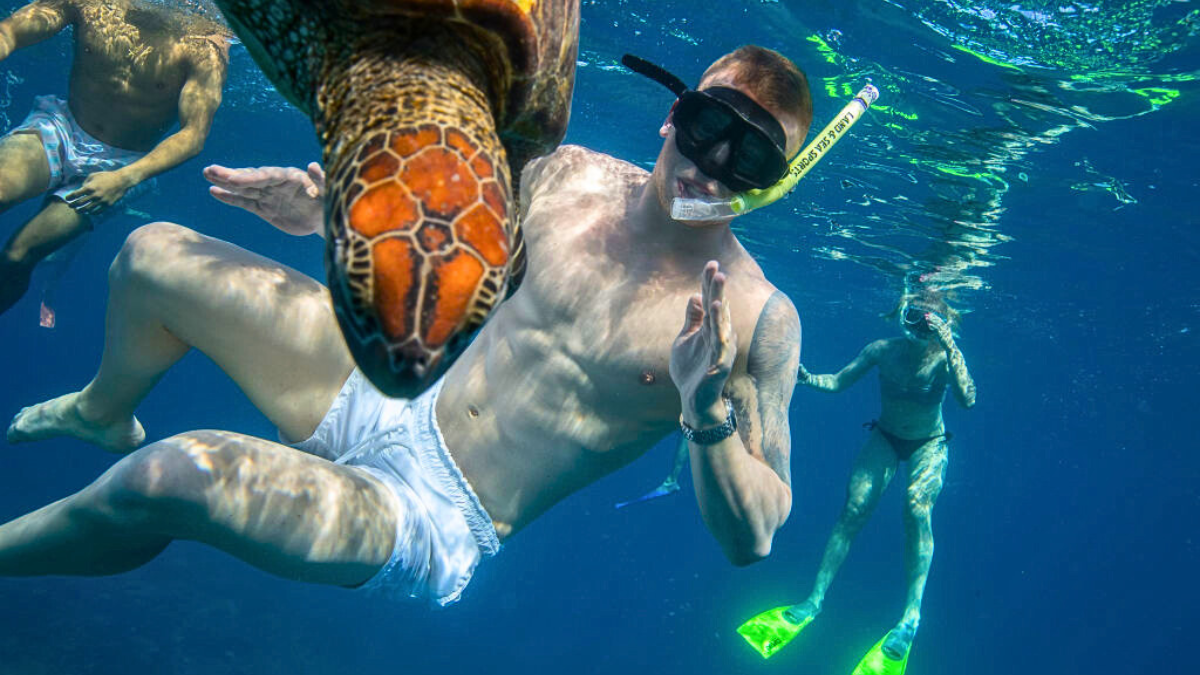
The plane banks above the island; a small emerald bullseye in the variegated blue of the lagoon. White tipped waves lap against an outer circle of coral. I’ve scored the co-pilot seat in the 13-seater Caravan aircraft, a slightly terrifying privilege, and I’m tempted to squeeze my eyes shut as we set up to land on the short grass airstrip bisecting the island.
Lady Elliot, a 45-hectare coral cay on the pristine far southern end of the Great Barrier Reef is one of only two coral cay islands with its own airstrip.
The winter months, when the water clarity is at its best and the marine life is most active, is the perfect time to visit – and with day-trip flights from Brisbane and the Gold Coast, you can be strapping on your fins ready for some underwater exploration in less than two hours and still be back for dinner.
Part of the Capricorn and Bunker group, Lady Elliot is an environmental riches-to-rags-to-riches again kind of story. For a century, the island was systematically denuded – stripped right down to its calcareous carbonate skeleton by guano farming and feral goats.
In the late 1960s, aviator and environmental pioneer, the late Don Adams leased the island from the Australian government and started a program of rehabilitation and revegetation.
 In 2005, conservationist Peter Gash, who had been operating the air charters to the island took on the lease and has built on Adams’ legacy, removing invasive species, regenerating topsoil and replanting more than 4000 native coral cay species.
In 2005, conservationist Peter Gash, who had been operating the air charters to the island took on the lease and has built on Adams’ legacy, removing invasive species, regenerating topsoil and replanting more than 4000 native coral cay species.
Today, the verdant Lady Elliot, which sits within a highly-protected Barrier Reef marine ‘Green Zone’ is thriving, as witnessed by its most prolific residents – 95 species of sea, land and shore birds from white capped noddies to sooty oyster catchers, who come here to nest in the pisonia trees or repose after a long migration.
Wildlife below the waterline is just as profuse, with more than 1200 marine and coral species.
The island experiences warm, blue-sky winter days, with the water a temperate 23°C, corresponding pretty much to the air temperature, but the option of a wetsuit is offered as we’re kitted out with our snorkels, goggles and fins.

Winter brings clear waters, making it the best time to visit the island. Photo: Getty
The water clarity is at its absolute best in winter due to the fact it’s the driest time of the year. It is also peak season for some species, such as manta rays; gentle alien-looking creatures whose pectoral fin span can reach up to seven metres.
“They’re sighted all year round but aggregate in larger numbers between May and August,” says Peter Gash’s daughter Amy, who’s taking an ‘out of office day’ and joining our small group.
“The cooler temperatures bring heightened activity levels like cleaning, courting and feeding,” she says.
Between June and October, Ms Gash says that migrating humpback whales are regularly sighted from the plane and the glass bottom boats.
“And almost daily during season, you can hear whale songs underwater while you’re swimming, snorkelling and diving,” she says.
 As part of the Lady Elliot day package, a glass bottom boat takes visitors to see a ‘cleaning station’ at the Lighthouse Bommie. Looking down deep below, we witness an extraordinary, almost human-like organisation of marine animals as small reef sharks, turtles and rays congregate and wait their turn to be cleaned of parasites by wrasse and surgeon fish.
As part of the Lady Elliot day package, a glass bottom boat takes visitors to see a ‘cleaning station’ at the Lighthouse Bommie. Looking down deep below, we witness an extraordinary, almost human-like organisation of marine animals as small reef sharks, turtles and rays congregate and wait their turn to be cleaned of parasites by wrasse and surgeon fish.
There are 20 dive and snorkel sites around the island, including snorkelling right off the beach in the shallow protected lagoon, a veritable garden of coral, ideal for first timers or less confident swimmers.
I’m placed in the intermediate group and we moor just off the beach, where there’s a rope to hang on to if you need a break but also to act as a guide over the best viewing spots. With a lazy kick we propel ourselves over bombies of hard corals and waving anemones and patches of sand where rays and small leopard sharks bask. We watch schools of brilliantly coloured fish, including the famous ‘Nemo fish’ dart among the coral, and marvel at gangs of ethereal, semi-transparent squid as they swim past.

The tiny island is teeming with wildlife above the waves as well. Photos: Natascha Mirosch, Getty
As well as manta rays, the other species Lady Elliot is famous for is turtles. The island is an important nesting site for green, hawksbill and loggerhead turtles and they are commonly sighted in the waters around the island. It’s rare not to have the opportunity to swim with them, and they seem unperturbed, even curious about our presence despite their grumpy old-man faces.
After lunch, there’s time to explore the island, to stretch out on a beach chair in the sun, or to take a walk to the historic, heritage-listed lighthouse, go on a guided tour to see the sustainable ethos in action, or have a reef walk over the lagoon at low tide. If you haven’t had enough, it’s possible to just walk straight off the beach into the water and coral gardens for another leisurely snorkel.

Photos: Natascha Mirosch, Getty
With the numbers of day guests limited and even with the presence of overnight guests, the island never feels crowded. The 3.5-star eco-resort, with a restaurant, bar and WIFI-free cabins spread across the island, is pleasant but low-fi – it’s all about what’s under the water and that, without question, is a five-star experience.
Day Tours to Lady Elliot Island are currently on special for $708 per adult until September 30 (normally $944) ex Gold Coast and $783 per adult ex Brisbane (Redcliffe) and include return flights, welcome drink, island tour, glass bottom boat tour and snorkel tour, buffet lunch, equipment, fish feeding and use of day guest facilities.
There are also flights from Bundaberg and Hervey Bay.
Natascha Mirosch was a guest of Lady Elliot Island
